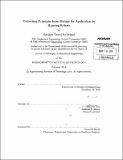| dc.contributor.advisor | Sangbae Kim. | en_US |
| dc.contributor.author | Haberland, Matthew Daniel | en_US |
| dc.contributor.other | Massachusetts Institute of Technology. Department of Mechanical Engineering. | en_US |
| dc.date.accessioned | 2014-06-13T22:38:37Z | |
| dc.date.available | 2014-06-13T22:38:37Z | |
| dc.date.copyright | 2014 | en_US |
| dc.date.issued | 2014 | en_US |
| dc.identifier.uri | http://hdl.handle.net/1721.1/87975 | |
| dc.description | Thesis: Ph. D., Massachusetts Institute of Technology, Department of Mechanical Engineering, 2014. | en_US |
| dc.description | Cataloged from PDF version of thesis. | en_US |
| dc.description | Includes bibliographical references (pages 149-158). | en_US |
| dc.description.abstract | When millions of years of evolution suggest a particular design solution, we may be tempted to abandon traditional design methods and copy the biological example. However, biological solutions do not often translate directly into the engineering domain, and even when they do, copying eliminates the opportunity to improve. A better approach is to extract design principles relevant to the task of interest and incorporate them in engineering designs when they outperform conventional solutions. This thesis presents an original, general framework for extracting engineering design principles from biology. Case studies involving legged robots introduce important elements of the framework. An investigation of the effect of swing leg retraction on the energetic efficiency of running proposes the use of optimal control in the principle extraction process and finds that swing leg retraction can minimize impact between the foot and the ground, but shows that this does not necessarily improve overall energetic efficiency. An analysis of the effect of a bioinspired tail on maneuverability motivates the importance of parameter variation for developing general conclusions and finds that tails can be more effective than reaction wheels when the time available for an aerial maneuver is short. Finally, case studies utilize the complete framework to extract principles regarding the effects of leg morphology on running robot performance. An examination of the effect of knee joint type on the energetic efficiency of running finds that telescoping legs tend to be more efficient than rotary-kneed legs for a class of simple robots and reveals a strong correlation among step size, speed, and energetic efficiency. A study of the effect of rotary knee joint direction on the energetic efficiency of running demonstrates that running robots with a knee joint oriented 'backwards', as bird legs appear, tend to be more efficient than robots with a knee joint oriented 'forwards', as human legs are. More generally, the case studies demonstrate the effectiveness of the framework for very complex and widely applicable principle extraction studies, the results of which can be utilized to save design resources and improve design performance. | en_US |
| dc.description.statementofresponsibility | by Matthew Daniel Haberland. | en_US |
| dc.format.extent | 158 pages | en_US |
| dc.language.iso | eng | en_US |
| dc.publisher | Massachusetts Institute of Technology | en_US |
| dc.rights | M.I.T. theses are protected by copyright. They may be viewed from this source for any purpose, but reproduction or distribution in any format is prohibited without written permission. See provided URL for inquiries about permission. | en_US |
| dc.rights.uri | http://dspace.mit.edu/handle/1721.1/7582 | en_US |
| dc.subject | Mechanical Engineering. | en_US |
| dc.title | Extracting principles from biology for application to running robots | en_US |
| dc.type | Thesis | en_US |
| dc.description.degree | Ph. D. | en_US |
| dc.contributor.department | Massachusetts Institute of Technology. Department of Mechanical Engineering | |
| dc.identifier.oclc | 880695121 | en_US |
